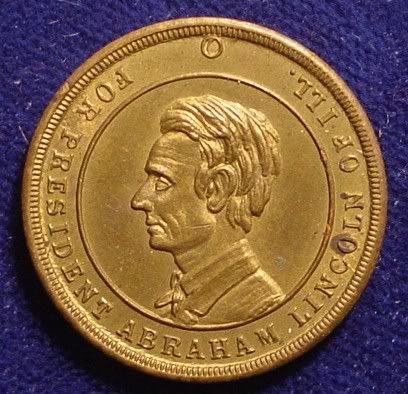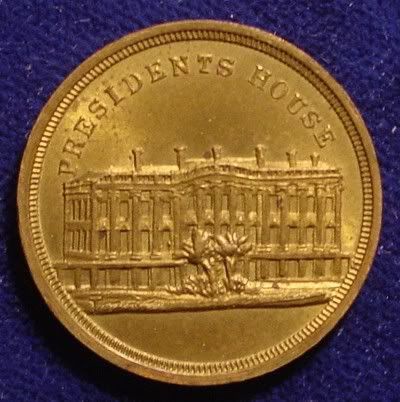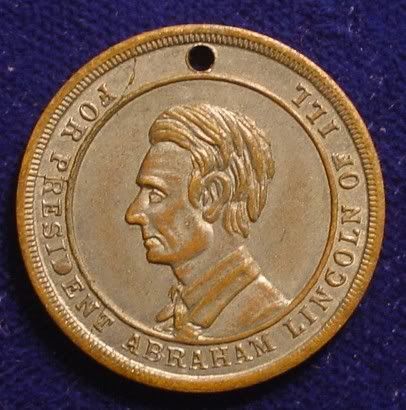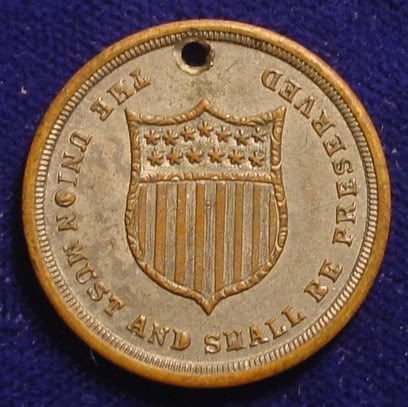A couple of Lincoln Civil War Tokens from the 1860 Election
One of the factors that defines a Civil War token is that it is a piece that was minted from 1861 to 1864. The year 1861 marked the beginning of the war, and in 1864 Congress enacted legislation that outlawed the used of such tokens in place of U.S. coinage. For whatever reason George and Melvin Fuld chose to include the so-called Wealth of the South series of tokens, which were dated 1860, in the Civil War token series.
The Wealth of the South tokens get their name from the pro southern token (there are actually several minor varieties of them) that had that as its title. Included in the series, which were made by the same die sinker, are tokens for each of the four candidates who ran for President in 1860. There are two minor obverse die Lincoln varieties, and here they are.
DeWitt number AL 1860-61 (obverse a.k.a. Fuld 507) features a young looking beardless Lincoln. All but one of the 1860 related Lincoln campaign pieces feature Lincoln without his trademark beard. He did not grow it until he had been elected and then kept it for the rest of his life. This is one way that collectors can distinguish the 1860 campaign pieces from the 1864 tokens and medalets. The reverse of this token is the "President's House" variety, which was paired with each of the other candidate's dies. This is the most commonly seen reverse for all four candidates.


DeWitt number AL 1860-62 (obverse a.k.a. Fuld 506) features to same design with slight variations. The one that collectors most often point out is the absence of the period after "ILL". There are other minor differences between the placement of the letters and Lincoln’s bust.
I believe that this die was made first and that it cracked part way through the production run. You will note that there is a crack to the right of the letter “F” in “FOR” and though the “R” in “PRESIDENT.” The reverse is features the slogan, “The Union must and shall be preserved.” These words were first spoken by Andrew Jackson at a Jefferson Day Dinner when vice president, John C. Calhoun, was challenging the Federal Government’s authority impose protective tariffs upon the states. This was known as the Nullification Crisis because Calhoun claimed that the states had the right to nullify any law that opposed that state’s interests. This is a very rare die combination.


The Wealth of the South tokens get their name from the pro southern token (there are actually several minor varieties of them) that had that as its title. Included in the series, which were made by the same die sinker, are tokens for each of the four candidates who ran for President in 1860. There are two minor obverse die Lincoln varieties, and here they are.
DeWitt number AL 1860-61 (obverse a.k.a. Fuld 507) features a young looking beardless Lincoln. All but one of the 1860 related Lincoln campaign pieces feature Lincoln without his trademark beard. He did not grow it until he had been elected and then kept it for the rest of his life. This is one way that collectors can distinguish the 1860 campaign pieces from the 1864 tokens and medalets. The reverse of this token is the "President's House" variety, which was paired with each of the other candidate's dies. This is the most commonly seen reverse for all four candidates.


DeWitt number AL 1860-62 (obverse a.k.a. Fuld 506) features to same design with slight variations. The one that collectors most often point out is the absence of the period after "ILL". There are other minor differences between the placement of the letters and Lincoln’s bust.
I believe that this die was made first and that it cracked part way through the production run. You will note that there is a crack to the right of the letter “F” in “FOR” and though the “R” in “PRESIDENT.” The reverse is features the slogan, “The Union must and shall be preserved.” These words were first spoken by Andrew Jackson at a Jefferson Day Dinner when vice president, John C. Calhoun, was challenging the Federal Government’s authority impose protective tariffs upon the states. This was known as the Nullification Crisis because Calhoun claimed that the states had the right to nullify any law that opposed that state’s interests. This is a very rare die combination.


Retired dealer and avid collector of U.S. type coins, 19th century presidential campaign medalets and selected medals. In recent years I have been working on a set of British coins - at least one coin from each king or queen who issued pieces that are collectible. I am also collecting at least one coin for each Roman emperor from Julius Caesar to ... ?
0
Comments
I've had just about enough of the 'post your order #' lessons for today
Lincoln set Colorless Set
And here is a piece for John Breckenridge who was one of Lincoln's rivals.
Stefanie
.
CoinsAreFun Toned Silver Eagle Proof Album
.
Gallery Mint Museum, Ron Landis& Joe Rust, The beginnings of the Golden Dollar
.
More CoinsAreFun Pictorials NGC
What's the story with that? Was it optional, or was it a do-it-yourself deal?
Lincoln set Colorless Set
<< <i>hmmm, looking again at the images, it looks like the first token(Fuld 507) should have had a hole drilled @ 12:00 on the obverse?
What's the story with that? Was it optional, or was it a do-it-yourself deal? >>
The dies for the Wealth of the South series of tokens were made by Benjamin True who was from Cincinnati, Ohio. True made the Wealth of the South dies plus campaign pieces for each of the four presidential candidates who ran in 1860.
Sometime after 1860 True sold the dies to another token maker. Most CWT collectors believe that the new owner was John Stanton who also lived and worked in Cincinnati. Stanton continued to make tokens from the dies, mostly for sale to collectors, perhaps during and certainly after the Civil War. He mixed (muled) the dies to make some really nonsensical combinations like an Abraham Lincoln obverse paired with a pro-southern reverse. All of this was done to provide collectors with rare items that they could show off to other collectors. These restrike tokens were seldom, if ever, holed.
Therefore I would say if you see one of these tokens with a hole and perhaps some wear, you are looking at an item that was more than likely used during the 1860 presidential campaign. Or, if it is a Wealth of the South piece with a hole, it was probably used before and during the Civil War by Confederate sympathizers or outright Rebels. . If you see a piece with no hole, and in high grade it may not have been used in the campaign. If you see a piece with illogical pairings of the dies, you looking at a made for collector piece that was struck after the Civil War. Those "nonsense" tokens are of no interest to me despite the fact that they are rare and bring very high prices.
- Marcus Tullius Cicero, 106-43 BC
PCGS Registries
Box of 20
SeaEagleCoins: 11/14/54-4/5/12. Miss you Larry!
<< <i>Very nice and ................I want to see more
Stefanie >>
OK. Here are the remaining two candidates who ran for President in 1860. This John Bell piece with the hole for suspension was probably issued for his presidential campaign before the Civil War.
And this Stephen Douglas piece MAY HAVE been issued for his campaign and not used. The slogan, "Our rights, the Constitution and the Union," could have worked for his "popular sovereignty" campaign, BUT the “our rights” part sounds more like a John Breckenridge piece. At any rate here’s my Stephen Douglas obverse. ("Our rights" referred to the "right" for Americans to own slaves which was a very important Breckenridge campaign position. BUT Douglas could have used it too because he thought that Americans should be able to own slaves in the states and territories if they voted to support slavery.)
my early American coins & currency: -- http://yankeedoodlecoins.com/
<< <i>Are the "O" devises drill bit guides? >>
Yes they provided the spot where the hole was be drilled into the piece so that it could suspended from a ribbon and worn. Some collectors shy away form the pieces with a hole, but if you are looking to collect an actual campaign piece and not something that was made just to sell to collectors there is nothing wrong with the holed pieces.
<< <i>
<< <i>Are the "O" devises drill bit guides? >>
Yes they provided the spot where the hole was be drilled into the piece so that it could suspended from a ribbon and worn. Some collectors shy away form the pieces with a hole, but if you are looking to collect an actual campaign piece and not something that was made just to sell to collectors there is nothing wrong with the holed pieces. >>
That gives me a whole different view on holed medals in general. Thank you.